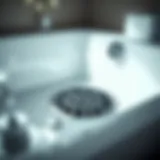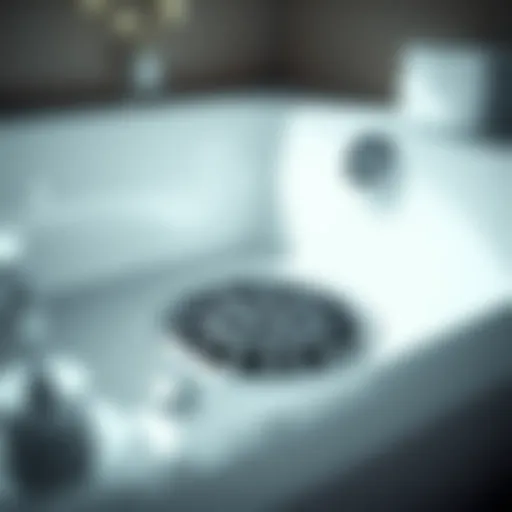Waterproof Backsplashes: A Complete Bathroom Guide
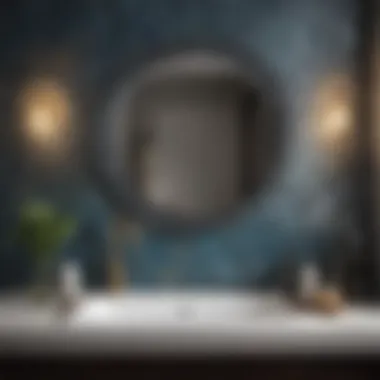

Intro
In any bathroom, the backsplash takes an important role. It protects walls from moisture and adds a layer of style. Understanding the significance of waterproof backsplashes is key for homeowners who want to combine function with aesthetics.
This guide will walk you through various aspects of waterproof backsplashes, from material choices to installation techniques. Whether you're a homeowner or a designer, this resource will help you navigate the options available.
Trending Styles
Modern Minimalism
Modern minimalism is characterized by clean lines and a clutter-free approach. In bathroom design, this style often emphasizes simplicity and functionality. A seamless glass or a solid surface like Corian works well. These materials not only provide waterproof protection but also create a stylish and contemporary look. When choosing colors, stick to whites or grays for that minimalist appeal.
Cozy Rustic
If you prefer a warm and inviting ambiance, the cozy rustic style is a great option. Natural stone, such as slate or travertine, can provide a beautiful and textured backdrop. Additionally, wooden accents, treated for moisture, can add character and warmth. This combination brings a homey feel while still being highly functional.
Color Palettes
Calming Neutrals
Calming neutrals are essential in creating a serene environment. Shades like beige, taupe, or soft greys can instill a sense of peace. When paired with a waterproof backsplash in the same palette, it allows for a cohesive look that is visually pleasing. It's especially relevant in tight spaces, where you want to enhance light and openness.
Bold Accents
For those looking to make a statement, bold accents can transform a bathroom backsplash into a focal point. Colors like deep navy or jewel tones work nicely against lighter walls. Incorporating bold patterns or tiles can add depth and interest without overwhelming the space.
Important Note: Choosing the right color and style will ultimately depend on your personal preferences and overall theme of the bathroom. Always consider harmony between the backsplash and the rest of the decor.
Prologue to Waterproof Backsplashes
Waterproof backsplashes are essential to modern bathroom design. The humidity and moisture levels in bathrooms are high. Therefore, ensuring that the surfaces are protected from water damage is critical. A well-chosen backsplash acts as both a barrier against moisture and a stylish element in the room. Homeowners often underestimate how much a backsplash can affect the longevity and cleanliness of walls. This guide will explore the ins and outs of waterproof backsplashes, focusing on their importance, material options, and practical tips for installation.
Understanding the Importance of Waterproofing
The significance of waterproofing in bathrooms cannot be overstated. Water that seeps into surfaces can cause mold, mildew, and structural damage. Thus, waterproofing is not just about aesthetics. It is about the long-term health of your bathroom space. When designing or renovating a bathroom, waterproofing should be a top priority. The right materials can help to create a barrier that withstands moisture.
Choosing the right material makes a huge difference. For example, ceramic tiles can handle moisture well when sealed correctly. On the other hand, some materials are more porous and can lead to problems over time. By understanding how waterproofing works, homeowners can choose backsplashes that offer durability and beauty.
Why Choose a Backsplash in the Bathroom
Having a backsplash in the bathroom serves multiple purposes. First, it establishes a focal point in the design. It can provide a splash of color or texture that elevates the overall aesthetic. A catchy design can significantly enhance the look of a basic vanity area, making it more inviting.
Second, a backsplash is practical. It protects the walls from water splashes caused by sinks and tubs. This diminishes the chances of damage due to water infiltration.
Lastly, maintenance becomes easier with a backsplash. Smooth surfaces allow for simple cleaning without the worry of damaging the wall underneath. Regular wiping is usually enough to keep your backsplash looking fresh. A dirty wall can lead to stains and discoloration, which are difficult and costly to fix.
In summary, waterproof backsplashes in bathrooms are indispensable for both functionality and aesthetic appeal. Investing time in selecting the right materials and designs will yield long-term benefits.
Key Materials for Waterproof Backsplashes
Understanding which materials to use for waterproof backsplashes is fundamental for ensuring their effectiveness and durability in a bathroom environment. The right materials not only provide aesthetic appeal but also contribute to the overall functionality of the space. Choosing wisely can prevent issues such as water damage, mold growth, and deterioration over time.
Ceramic and Porcelain Tiles
Ceramic and porcelain tiles remain some of the most popular choices for waterproof backsplashes. Both are derived from clay, but porcelain is fired at higher temperatures, making it denser and less porous than ceramic. This characteristic grants porcelain a superior water resistance. When installing these tiles, the grout used can also influence the waterproofing effectiveness. It is essential to choose a high-quality, waterproof grout to minimize water penetration.
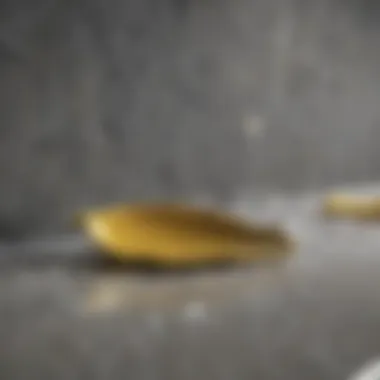

Maintenance for ceramic and porcelain tiles is straightforward. Regular cleaning with mild detergents helps maintain their appearance, while their rigidity provides long-term durability. Additionally, these tiles come in various colors and patterns, offering homeowners a wide array of design options to suit their taste and bathroom decor.
Glass Tiles
Glass tiles offer a sleek and modern look that can brighten up a bathroom space. Their non-porous nature makes them inherently waterproof, making them an excellent choice for backsplashes in areas prone to moisture. Glass tiles reflect light, which can create a sense of depth and space, enhancing the overall aesthetic of the room.
However, these tiles require careful installation and a specialized adhesive to ensure their integrity over time. It is crucial to avoid cracks and chips as they can compromise the waterproof abilities. Regular cleaning is necessary as glass surfaces can show water spots more readily than other materials. Despite needing attentive care, the visual appeal of glass tiles often justifies its higher price point and maintenance effort.
Natural Stone Options
Natural stones like granite, marble, and slate are chosen for their raw, earthy aesthetics. These materials offer a unique visual appeal, with each piece presenting individual patterns and colors. However, natural stone is generally more porous than other materials, meaning it may require sealing to become truly waterproof. Various sealants are available, and applying them regularly can help maintain the stone's integrity.
While natural stone can be more expensive and requires more upkeep, its lasting value and timeless appearance can elevate a bathroom considerably. Homeowners should also be aware of the scratch and heat resistance of these materials as it varies by type. Overall, natural stones bring depth and character to a bathroom that few other materials can replicate.
Vinyl and Laminate Backdrops
Vinyl and laminate backsplashes are economical options that don’t skimp on style. Correlated with a wide array of designs and colors, these materials can mimic the appearance of more expensive alternatives without the hefty price tag. They are inherently waterproof, making them practical for bathroom environments.
Installation is often easier with vinyl and laminate, which can be adhered directly to walls with minimal preparation, saving time and labor costs. It is important to note, however, that while they resist moisture effectively, prolonged exposure to standing water may affect their performance. Regular maintenance includes simple wipe-down cleaning, making them ideal for busy households.
Design Considerations for Choosing a Backsplash
Choosing a backsplash for your bathroom is not just about aesthetics; it involves multiple aspects that contribute to the overall functionality and appearance of the space. A well-selected backsplash strikes a balance between style and practicality. It can offer a necessary barrier against moisture and stains, while also enhancing the visual appeal of the bathroom. With endless design possibilities, understanding the key considerations can help homeowners make informed decisions.
Style and Aesthetic Appeal
The style of the backsplash plays a critical role in the bathroom's overall ambiance. It is important to align the design with the existing decor theme. For instance, a modern bathroom may benefit from sleek, minimalist glass tiles, while a traditional space might call for classic ceramic or natural stone options. Moreover, incorporating patterns or unique designs can create a focal point or catch the eye.
- Function Meets Fashion: A backsplash should not only serve its practical purpose but also reflect personal taste. Homeowners may opt for vibrant colors for a pop of energy, or soft hues for a soothing environment.
- Consistency: The chosen style must harmonize with other elements in the bathroom, such as cabinetry and fixtures, ensuring a cohesive look.
Color Coordination
Color choices can significantly impact the mood and appearance of a bathroom. Selecting the right colors for the backsplash helps in complementing other colors within the space. Here are some factors to consider regarding color coordination:
- Neutral Palettes: Whites, greys, and beiges offer versatility and ease of pairing with other shades. Neutral colors can create a clean, timeless look while enhancing natural light.
- Bold Accents: Adding a bold-colored backsplash can make a statement and bring vibrancy. However, it’s essential to ensure that it doesn’t clash with other important features in the bathroom.
- Consider Lighting: Different lighting can change how colors appear. Observing the backsplash in various lighting conditions can help in making the best choice.
"The right color coordination can transform an ordinary bathroom into a cohesive sanctuary, inviting comfort and relaxation."
Texture and Finish
Texture and finish have a vital effect not just on aesthetics but also on functionality. Textured backsplashes can add depth, while smooth finishes facilitate easier cleaning. Thus, it is crucial to find a textural balance that aligns with both style and practicality:
- Glossy Finishes: Excellent for reflecting light, these finishes can make smaller spaces appear larger. They are also easier to clean but may show water spots more easily.
- Matte Finishes: These provide a subtle, elegant look, but they might require more maintenance as they can trap dirt and moisture more than glossy surfaces.
- Textured Tiles: Dimensional designs, such as 3D tiles, can create visual interest and character but may require extra cleaning diligence.
Ultimately, the combination of the right style, color coordination, and texture will lead to a successful backsplash choice that meets the homeowner's needs and enhances the bathroom’s appeal.
Functionality and Practical Benefits
The functionality and practical benefits of waterproof backsplashes are central to their appeal in bathroom design. These surfaces serve more than an aesthetic purpose; they play a critical role in maintaining a clean, safe, and durable environment. Homeowners can make informed choices by understanding the specifics of these benefits.
Durability and Longevity
When selecting a backsplash for the bathroom, durability is paramount. The bathroom's humid environment can weaken ordinary materials over time. Waterproof backsplashes, constructed from durable substances like ceramic, porcelain, or glass tile, can withstand this moisture without warping or degrading.
Moreover, the longevity of these backsplashes means fewer replacements in the long run. Investing in high-quality materials translates to savings and less hassle from ongoing repairs. Homeowners should consider this long-term viability when choosing their materials.
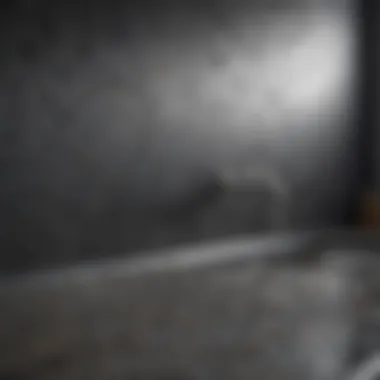

Ease of Cleaning and Maintenance
Cleaning and maintenance should never be overlooked in a busy bathroom. Many waterproof backsplashes feature smooth surfaces which facilitate easy cleaning. Regular upkeep requires just mild soap and water for maintenance. This simplicity becomes an advantage for busy house owners who wish to avoid elaborate cleaning routines.
In contrast, porous materials may trap moisture and grime, leading to more extensive cleaning needs. Hence, opting for smoother, non-porous options enhances user experience. Homeowners can enjoy the functionality of a beautiful bathroom without dedicating excessive time to upkeep.
Mold and Mildew Resistance
A critical concern for any bathroom design is the risk of mold and mildew due to moisture. Waterproof backsplashes offer a strong defense against mold growth, primarily when made from materials like glass or high-quality ceramics. These materials do not hold moisture, reducing the chance for mold to develop.
It is essential to select backsplashes with treated surfaces or added protective coatings to further enhance mold resistance. Households with children or those susceptible to allergies can benefit significantly from minimizing mold risks. This consideration leads to a healthier living environment and peace of mind for homeowners.
"Choosing a waterproof backsplash is not just about style; it's about creating a space that stays functional and welcoming over time."
Installation Techniques for Waterproof Backsplashes
When considering waterproof backsplashes in bathrooms, installation techniques play a pivotal role. Proper installation not only ensures the functionality of the backsplash but also enhances its durability and visual appeal. Understanding these techniques can prevent common issues like water damage, mold growth, and aesthetic flaws that could arise from improper installation. Therefore, a thorough comprehension of installation methods will maximize the benefits and longevity of the waterproof backsplash.
Preparation of Surfaces
Preparation of the surfaces is an essential step in the installation process that should not be overlooked. The surfaces where the backsplash will be applied must be clean, dry, and smooth. Dust, grease, or moisture can interfere with the adhesion, potentially causing the backsplash to peel or dislodge over time.
Here are the key steps to prepare the surface:
- Cleaning: Use a mild detergent or household cleaner to wash the area. This removes any grime or residues.
- Drying: After cleaning, wipe the surface with a dry cloth to ensure it is free of moisture.
- Smoothing: If the wall has imperfections, sand or patch any rough areas for a flat and even surface.
- Priming: In some cases, applying a primer may be necessary to enhance adhesion, particularly on porous materials.
Taking these steps ensures that the surface is conducive for a successful installation.
Adhesives and Grout Selection
The choice of adhesives and grout is equally important when installing a waterproof backsplash. The right products will support the overall integrity and waterproof qualities of the backsplash.
- Adhesives: It is recommended to use a high-quality tile adhesive appropriate for wet areas. Thin-set mortar is commonly used for tile installations. Liquid waterproof adhesives can also be effective, especially for glass tiles.
- Grout: Selecting the right grout can influence both functionality and aesthetics. Epoxy grout is known for its strong resistance to moisture and stains, making it ideal for damp environments. Conversely, standard cement-based grout may require sealing to protect against water damage.
In both instances, it is wise to follow the manufacturer's instructions for the best results.
Step-by-Step Installation Process
Embedding a waterproof backsplash involves a systematic approach to ensure precision and adherence to standards. Here’s a simplified version of the step-by-step process:
- Mark the Area: Use a level to outline where the tiles will go, ensuring that the backsplash will be straight.
- Apply Adhesive: Use a notched trowel to spread the adhesive on the surface. Make sure to apply enough, but not so much that it will ooze out when tiles are pressed in.
- Set the Tiles: Firmly press each tile into the adhesive, moving slightly to ensure a full bond. Leave gaps for grout between each tile.
- Cut Tiles as Needed: For any edges or corners, you may need to cut tiles to fit. A tile cutter can help achieve a clean edge.
- Allow to Dry: Follow the adhesive manufacturer’s instructions for drying time before proceeding.
- Grouting: Once the tiles are set, spread grout over the tiles using a float. This fills the gaps between the tiles.
- Clean Excess Grout: Wipe away excess grout before it hardens. It can be contentious if not cleaned promptly.
- Seal the Grout: After the grout has fully cured, applying a sealant can offer additional moisture protection.
By adhering to these steps, the backsplash installation will not only look attractive but will also function well over time, providing the desired aesthetic appeal and practical benefits.
Cost Considerations and Budgeting
Understanding the cost considerations for waterproof backsplashes is crucial for homeowners and designers alike. When embarking on a renovation or a new construction project, budgeting effectively is key to achieving a satisfactory outcome. It ensures that design dreams can be accomplished within financial limits. This section discusses various elements related to costs, including material choices, potential installation expenses, and overall value for money.
Material Costs Overview
The costs for waterproof backsplash materials vary significantly based on the materials chosen. Here are several points to evaluate:
- Ceramic Tiles: Generally on the lower end of the cost spectrum, ceramic tiles can be affordable yet durable. Prices can range widely, often from $1 to $15 per square foot.
- Porcelain Tiles: A step up in price, these can range from $3 to $25 per square foot. Porcelain is denser and offers better moisture resistance than ceramic.
- Glass Tiles: Glass options often fall between $7 to $50 per square foot due to their aesthetic appeal and high resistance to stains.
- Natural Stones: Materials like granite or marble can be the most expensive, typically costing $10 to $100 per square foot, depending on quality and finish.
- Vinyl and Laminate: These are budget-friendly choices, often priced around $2 to $8 per square foot. They mimic other materials while being easy to install.
In summary, understanding the cost of materials is essential, as it directly impacts budget planning and material selection.
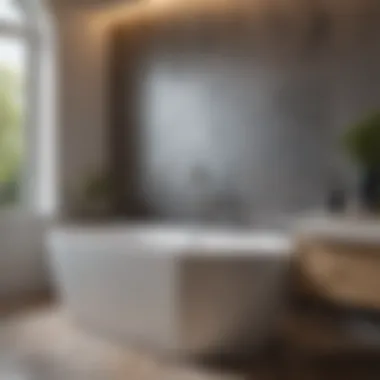

Potential Installation Expenses
Installation costs can significantly influence the overall budget for backsplash projects. These costs often depend on labor, complexity, and time required.
- Professional Installation: Hiring professionals can add $40 to $100 per hour, depending on skill level and location. Complex installations with intricate designs will likely cost more.
- DIY Installation: Opting for a do-it-yourself approach can save money. However, specific skills may be required, especially for tile work.
- Tools and Supplies: If undertaking a DIY project, consider costs for tools such as tile cutters, grouts, and adhesives. Initial investment might range from $50 to $300.
It is clear that installation costs vary widely based on the approach and complexity. Therefore, careful planning and understanding of potential expenses can prevent budget overruns.
Value for Money Analysis
Finally, evaluating the value for money in waterproof backsplashes involves considering longevity and maintenance. Investing slightly more in high-quality materials may yield better long-term results. Some factors to consider include:
- Durability: Higher-priced options like natural stone might have a steeper initial cost but often outlast cheaper alternatives, providing better value over time.
- Maintenance Costs: Some materials require more maintenance, which can lead to increased costs over time. Understand how to care for the material you choose.
- Impact on Property Value: A stylish, well-installed backsplash can enhance the overall aesthetics of the bathroom, potentially increasing home value and appeal.
As such, analyzing both immediate costs and long-term value is essential. This consideration helps identify materials that align with budgets and desired outcomes.
A well-planned budget can greatly influence the success of your backsplash project while also providing insights into the best materials and installation methods.
By thoroughly analyzing material costs, installation expenses, and the overall value for money, homeowners can make informed decisions that align with their style preferences and financial capabilities.
Maintenance Tips for Waterproof Backsplashes
Maintaining waterproof backsplashes is crucial for ensuring their longevity and visual appeal. Regular upkeep can prevent damage and deterioration caused by moisture, mold, and mineral buildup. Understanding how to properly care for these fixtures not only extends their life but also enhances the overall aesthetic of your bathroom. In this section, we delve into essential maintenance routines, as well as insights into necessary repairs and replacement strategies.
Regular Cleaning Routines
Regular cleaning is central to the maintenance of waterproof backsplashes. A consistent regimen helps to eliminate soap scum, mildew, and hard water stains that can develop over time. Here are some effective practices:
- Use Gentle Cleaners: Avoid harsh chemicals that can damage the surface of materials like glass or natural stone. Instead, opt for a mixture of water and mild detergent to effectively clean without causing harm.
- Soft Cloths and Sponges: When cleaning, use soft materials to avoid scratching the surface. Microfiber cloths and non-abrasive sponges are great choices.
- Rinse Thoroughly: After cleaning, ensure that all cleaners are rinsed away completely. Any residue left behind can lead to build-up and discoloration.
- Drying the Surfaces: A towel can be used to dry the backsplash after cleaning. This step helps prevent water spots and further mineral build-up.
Regular cleaning not only enhances appearance but also contributes to a healthier environment in your bathroom.
Repair and Replacement Needs
Over time, even the most durable waterproof backsplashes may require repair or replacement. Being proactive can prevent minor issues from becoming major problems. Important considerations include:
- Inspect Regularly: Regular inspections help identify any cracks, chips, or peeling grout. Early detection allows for immediate action, which can be less costly than extensive repairs later.
- Grout Maintenance: Grout can degrade over time. Re-grouting may be necessary if you notice discoloration or crumbling. This process serves not only to improve appearance but also to maintain moisture resistance.
- Replacing Damaged Tiles: If individual tiles are cracked or broken, replacing them promptly is vital. Leaving them damaged can lead to further issues with moisture, which can escalate problems like water damage.
- Consult Professionals When Needed: Some repairs may need professional help, particularly if they involve structural elements or extensive tiling. Consider seeking expert advice to ensure the work is done correctly.
Regular maintenance of waterproof backsplashes is essential for their durability and functionality in bathrooms. By adopting a consistent cleaning routine and being vigilant about repairs, homeowners can ensure their backsplashes remain both beautiful and effective.
Epilogue: The Future of Bathroom Backsplashes
Emerging Trends in Bathroom Design
Modern bathroom design is witnessing a shift towards integrated spaces where style transcends functionality. Backsplashes are no longer mere afterthoughts. Homeowners increasingly favor unique materials and finishes that reflect personal style while offering practicality.
A few notable trends include:
- Bold Patterns and Colors: Many homeowners opt for vibrant tiles that act as statement pieces.
- Mixed Materials: Combining glass, wood, and stone can create striking contrast and depth.
- Smart Functionality: Integration of technology, like LED lighting within backsplashes, is becoming popular.
These trends not only enhance the visual appeal but also elevate the overall functionality of the bathroom.
Sustainability Considerations
The focus on sustainability has become a significant aspect of bathroom design. Environmentally friendly materials like recycled glass tiles and sustainably sourced natural stones are gaining attention. Homeowners are prioritizing products that lower their carbon footprint while maintaining longevity and beauty. Various eco-friendly options, such as low VOC adhesives and finishes, are widely available.
"Sustainable choices in home design not only benefit the planet but often provide superior durability and performance."
Implementing these sustainable practices results in a more responsible design approach and could enhance property value. As awareness grows, the demand for sustainable bathroom backsplashes will likely rise, molding future design choices.
In summary, the future of bathroom backsplashes is shaped by trends that blend aesthetic innovation with practical solutions. Homeowners can create spaces that are not only visually pleasing but also attentive to sustainability, ensuring a greener future.




